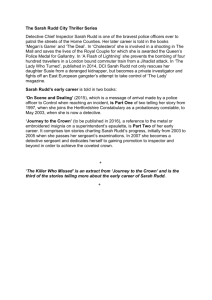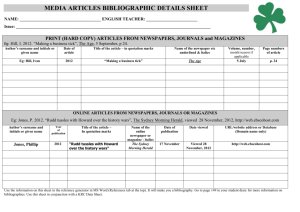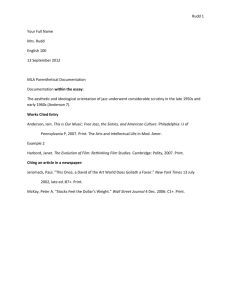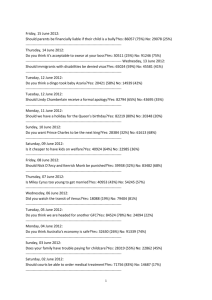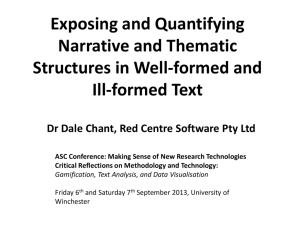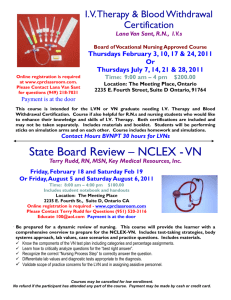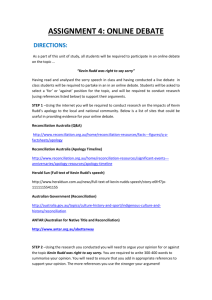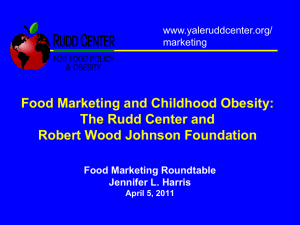AAII 2015 talk final AAII Seminar 2015
advertisement
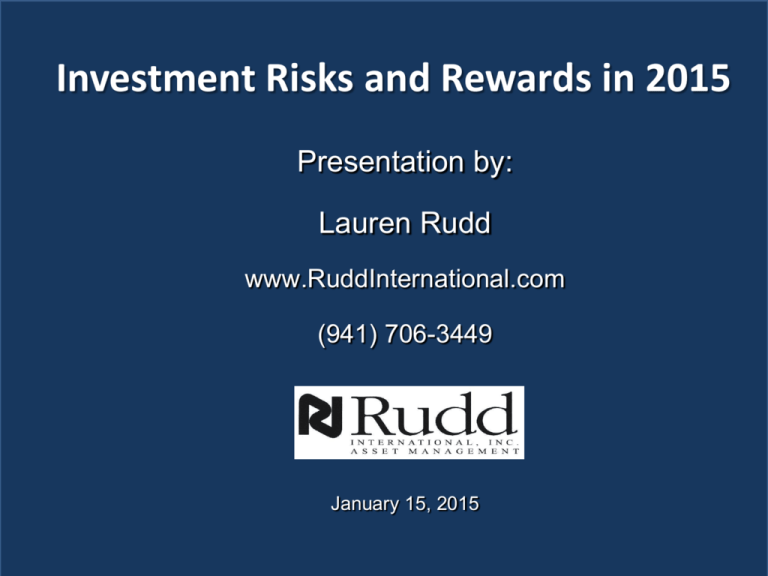
Investment Risks and Rewards in 2015 Presentation by: Lauren Rudd www.RuddInternational.com (941) 706-3449 January 15, 2015 Building a Successful Portfolio 01/15/2015 © Rudd International 2 What you will learn • • • • • • Where we have been Where we are going – What is the risk Importance and use of economic data The stock versus bond decision Dividing up you equity dollars Some investment ideas 01/15/2015 © Rudd International 3 A Year to Remember 01/15/2015 © Rudd International 4 2014 in Review 01/15/2015 © Rudd International 5 2014 in Review 01/15/2015 © Rudd International 6 The Bull Refuses to Die 01/15/2015 © Rudd International 7 How Stocks React to Interest Rate Hikes 01/15/2015 © Rudd International 8 Going Forward 01/15/2015 © Rudd International 9 Do Not Miss The Best Days 01/15/2015 © Rudd International 10 What Will 2015 Bring • S&P 500 earnings per share rising 7.5% • S&P 500 to end next year at 2350, up 17% • Price of oil ???? • Every $10-a-barrel drop in the average annual price equates to about 0.5% increase in GDP • GDP growth of 2.8% to 3% 01/15/2015 © Rudd International 11 Decent Value 01/15/2015 © Rudd International 12 Patience is a virtue • Volatility is not just back…it never left. Financial market volatility has always been and always will be an integral part of investing. • If you lose sleep over a dip in the market, or even a 10% correction, you need to bone up on patience. • No one in the history of the stock market has ever been able to accurately and consistently time corrections. • Wall Street moves two steps forward and then one step back. When it takes a step back, don't panic or sell 01/15/2015 © Rudd International 13 Unrealistic Expectations • You don’t go to the gym for a week and expect to be Mr. Universe. • You don’t go from an entry level position to C-level executive in a month. • Nobody jumps from arithmetic to calculus in a month. • Yet people want the market to make them rich overnight. • Investment strategies are not, and should not, be designed for overnight success. 01/15/2015 © Rudd International 14 Global Equity Forecasts 01/15/2015 © Rudd International 15 Slow Global Growth • The emerging markets of Brazil, Russia, India and China collectively known as the "BRICs" — will likely grow in 2015 at their slowest pace in six years. • China may expand 6.5 percent or more, a far cry from the nearly double-digit growth it enjoyed for decades. Europe and Japan will be lucky to expand even 1 percent. • Exports account for just 14 percent of U.S. output, the smallest share among the 34 mostly rich members of OECD. • Look for European Central Bank to ramp up its stimulus efforts by buying government bonds. • Japan's central bank is buying government bonds and other financial assets in a bid to boost inflation and stimulate growth. 01/15/2015 © Rudd International 16 Economic Growth in 2015 • • • • • • 3.1 percent advance in GDP Jobless rate down to 5.4 percent Global growth up 3.4 percent China slowing to a 7.0 percent pace Europe up 1.2 percent Japan up 1.0 percent 01/15/2015 © Rudd International 17 Economic Growth in 2015 cont. • • • • Federal funds at 0.75% by the end of 2015 Corporate profits up 6.7 percent S&P 500 at 2,167 by the end of 2015 Exports to grow by 5.4 percent 01/15/2015 © Rudd International 18 10-Year Treasury 01/15/2015 © Rudd International 19 Where the Wealthy Keep Their Money • The top 1% of Americans-who have a net worth of more than $7.8 million-hold nearly half their gross assets in unincorporated business equity and other real estate. • They have an additional 27% of wealth in financial securities. • Very little of their wealth is tied up in their personal residences. 01/15/2015 © Rudd International 20 Where the Wealthy Keep Their Money 01/15/2015 © Rudd International 21 Who Holds What Where 01/15/2015 © Rudd International 22 2 out of 2862 Who Routinely Trounces the Stock Market - Try 2 Out of 2862 Funds 01/15/2015 © Rudd International 23 Laggards 01/15/2015 © Rudd International 24 Add Insult to Injury • As of Dec. 15, dozens of mutual funds paid out taxable gains to their shareholders • As of Dec. 19, more than 79% of all funds had failed to beat their market benchmarks • $2.6 billion Janus Forty Fund, generated a market-lagging return of 8.3%. • On Dec. 17, the fund’s S share class paid out $0.76 in short-term capital gains and $13.44 in long-term capital gains 01/15/2015 © Rudd International 25 Exchange Traded Funds (ETFs) • Index funds suffer from their emphasis on momentum over value • Benchmark indexes tend to be capitalization weighted; the highest allocations go to the market’s largest companies • Increased investment in index funds means even more money goes into those stocks • Cheaper and more defensive stocks are ignored. • The result is increased volatility, as ever-fewer stocks dominate market capitalization and trading volume. That can set up the market — and index funds — for a greater fall as investors abandon the momentum stocks that had become such major index constituents. 01/15/2015 © Rudd International 26 Oil Stats • 16 states benefit from high oil prices, of which six really rely on oil for job growth • One percent of employment growth in the past four years has come from oil jobs, 2 percent if you include oil-related jobs • 10 percent of stocks in the S&P 500 are hurt by the decline in oil. 12 percent including oil-related stocks • Down cycles in oil tend to be self-correcting in 18 months 01/15/2015 © Rudd International 27 Supply Is Not The Issue The Saudis have two targets in their latest oil war • The first is trying to squeeze U.S. shale oil—which requires higher prices to remain competitive with conventional production—out of the market. • Secondly, the Saudis are also punishing two rivals, Russia and Iran, for their support of Bashar alAssad’s regime in the Syrian civil war. • The Iranian regime—and to a lesser extent, Russia—have provided the weapons and funding to keep Assad in power. 01/15/2015 © Rudd International 28 Inflation 01/15/2015 © Rudd International 29 Economic models Use one or more economic indicators to predict a level of economic or financial activity 01/15/2015 © Rudd International 30 Path to investment decisions Economic indicators Analysis Forecasts Forecasts Analysis Investment decisions Investment decisions Stock Selection Models Individual stock selections 01/15/2015 © Rudd International 31 Wall Street 01/15/2015 © Rudd International 32 So is this the time to invest 01/15/2015 © Rudd International 33 5 Ways to lose money on Wall Street • Denial - The trend isn't real • Skepticism - it's too risky • Bargaining - I'll invest if the price is right • Regret - God, I've missed it • Panic - I've got to buy in 01/15/2015 © Rudd International 34 Portfolio Management Process It all comes down to: How you invest What you invest in How do you hold on to your profits 01/15/2015 © Rudd International 35 IBM IBM is the poster child of companies using buybacks to hide deteriorating fundamentals 01/15/2015 © Rudd International 36 Perception problem • 40% of 18-29 year-olds say cash is their preferred way to invest money they don’t need for at least 10 years -- despite the fact that the S&P 500 has gained 17% over the past year while the yield on cash investments is below 1%. • Americans overall chose cash as their favorite long-term investment. In fact, 1 in 4 Americans prefer cash investments for money they will not need for at least 10 years. Stocks came in third with 19% of the vote. 01/15/2015 © Rudd International 37 01/15/2015 © Rudd International 38 Investment Management It all comes down to: • How you invest • What you invest in • How do you hold on to your profits 01/15/2015 © Rudd International 39 Goal Your goal should be: • Capital gain of 8% to 10% • Dividend yield of 3% to 4% • For a total of 11% to 14% 01/15/2015 © Rudd International 40 Asset Allocation Large Capitalization U.S. Equities Small Capitalization Value Growth Value Growth Equities (Stocks) Europe International Markets Pacific Region Emerging Markets Fixed Income Barclay’s Aggregate Bond (Bond) Cash Equivalents 01/15/2015 © Rudd International 41 Asset allocation • Single most important decision you make • Get it wrong and you are doomed • Academic papers show that 90 -95 percent of returns are based on the initial bond versus stock decision • DO NOT use a 60-40 fixed benchmark 01/15/2015 © Rudd International 42 Screening • Many investors use "screens" to select investments, meaning that they use a number of quantitative criteria and examine only the companies that meet those criteria • Warning = Do not throw the baby out with the bath water • AAII’s Stock Investor Pro 01/15/2015 © Rudd International 43 Methodology • Dividends – 8 to 10 consecutive years of rising dividends • Intrinsic Value – ValuePro – ValuePro.net • Free Cash Flow to Equities • Discounted Earnings • Dividend Discount Model (2 stage) 01/15/2015 © Rudd International 44 Intrinsic value model- FCFF • FCFF - the cash that is left over after payment of all hard cash expenses and all operating investment • FCFF = NOP – Taxes – Net Inv – Net Change in Working Capital • ValuePro.net 01/15/2015 © Rudd International 45 Intrinsic value – Dividends • • • • • 01/15/2015 Dividend discount model Used by every analyst Many varieties Can be found on the internet Excel program available © Rudd International 46 Tactical Managing for Income: Tactical Identify Dividend Achievers Determine Intrinsic Value of Individual Companies Forecast Financials Develop An Optimal Portfolio of 15 to 20 Companies 01/15/2015 © Rudd International 47 Strategic Managing Risk: Strategic Identify Systemic or Non-Diversifiable Risks Also referred to as “Market Risk” Determine Risk vs Reward Adjust Portfolio for Maximum Risk/Reward Ratio 01/15/2015 © Rudd International 48 Value Investing • • • • • 01/15/2015 Low P/E ratio Low Price/sales ratio Low Price/Cash Flow Low Price/book ratio High Dividend yield © Rudd International 49 Value Guidelines • • • • • • • Share price < than 2/3 of intrinsic value P/E ratios in the lowest 10% Stock price < than tangible book value Debt to Equity ratio < 0.75) Current assets 2X current liabilities Dividend yield 2/3 of AAA bond yield Earnings CAGR > 7% over 10 years 01/15/2015 © Rudd International 50 Growth Investing • • • • • 01/15/2015 High earnings growth rate High sales growth rate High return on equity High profit margin No or low dividend yield © Rudd International 51 Growth Guidelines Company Size Minimum 5 Year Growth Greater than $4B 5% Less than $4B and Greater than $400M 7% Less than $400 M 01/15/2015 12% © Rudd International 52 Does it Work Here is the proof: • Student Example • Rudd International Example 01/15/2015 © Rudd International 53 Rudd International- 2014 Results 01/15/2015 © Rudd International 54 Rudd International – 10-Year Results 01/15/2015 © Rudd International 55 Student Portfolio 01/15/2015 © Rudd International 56 2014 Newspaper • • • • • • • • • • • • Biogen Idec (BIIB) up 5.52 percent Gilead (GILD) up 34.17 percent AbbVie (ABBV) up 40.68 percent Abbott Labs (ABT) up 15.89 percent Aflac (AFL) down 9.60 percent MWI Veterinary Supply (MWIV) down 10.27 percent Intel (INTC) up 51.26 percent Tractor Supply (TSCO) up 4.86 percent United Technologies (UTX) down 0.69 percent Toro (TTC) up 6.66 percent AmerisourceBergen (ABC) up 27.58 percent Cummins (CMI) up 12.10 percent. • The capital appreciation for the group 16.19 percent year-to-date. • The average dividend yield for the group 1.66 percent • Total return 17.85 percent. 01/15/2015 © Rudd International 57 2015 Newspaper 1. Biogen Idec (BIIB) 7. Procter & Gamble (PG) 2. Gilead (GILD) 8. Norfolk Southern (NSC) 3. Intel (INTC) 9. Tech Data (TECD) 4. Tractor Supply (TSCO) 10. Energy Transfer Equity (ETE) 5. Hasbro (HAS) 11. Linn Energy (LINE) 6. Realty Income (O) 12. PepsiCo (PEP) 01/15/2015 © Rudd International 58 So Where Do We Go From Here • Consumer goods – Hasbro – HAS • Consumer goods – JM Smucker – SJM • Health care – Gilead Sciences – GILD • Health care – AbbVie – ABBV • Telecommunications – AT&T – T • Technology – Diebold – DBD • Technology – Tech Data – TECD 01/15/2015 © Rudd International 59 So Where Do We Go From Here – cont. • Basic materials – HollyFrontier – HFC • Energy – Transfer Equity – ETE • Basic materials – Schlumberger – SLB • International – Novartis ADR- NVS • Transportation – Norfolk Southern – NSC • Real Estate – Realty Income – O • Industrial goods – Babcock & Wilcox - BWC 01/15/2015 © Rudd International 60 So Where Do We Go From Here – cont. • Technology – Apple – AAPL • Health care – Zimmer – ZMH • Health care – Stryker – SYK • Health care – Varian Medical – VAR • Consumer goods – Clorox – CLX • Consumer goods – Church & Dwight – CHD 01/15/2015 © Rudd International 61 So Where Do We Go From Here – cont. • • • • • Consumer goods – Kellogg – K Defense – General Dynamics – GD Industrial goods – Toro – TTC Technology – Intel – INTC Basic materials – Valero Energy – VLO 01/15/2015 © Rudd International 62 Epilog • • • • • 01/15/2015 Need help - email me LVERudd@aol.com Slides on my web site RuddReport.com Put Seminar in subject line © Rudd International 63 Stick with a Bullish Strategy 01/15/2015 © Rudd International 64 01/15/2015 © Rudd International 65 Disclosure The data and analysis contained herein are provided "as is" and without warranty of any kind, either expressed or implied. Rudd International, any of its affiliates or employees, or any third party data provider, shall not have any liability for any loss sustained by anyone who has relied on the information contained in any Rudd International literature or marketing materials. All opinions expressed herein are subject to change without notice, and you should always obtain current information and perform due diligence before investing. Rudd International accounts that Rudd International or its affiliated companies manage, or their respective shareholders, directors, officers and/or employees, may have long or short positions in the securities discussed herein and may purchase or sell such securities without notice. Rudd International uses and has historically used various methods to evaluate investments which, at times, produce contradictory recommendations with respect to the same securities. When evaluating the results of prior Rudd International recommendations or Rudd International performance rankings, one should also consider that Rudd International may modify the methods it uses to evaluate investment opportunities from time to time, that model results do not impute or show the compounded adverse effect of transactions costs or management fees or reflect actual investment results, that some model results do not reflect actual historical recommendations, and that investment models are necessarily constructed with the benefit of hindsight. For this and for many other reasons, the performance of Rudd International’s past recommendations and model results are not a guarantee of future results. The securities mentioned in this document may not be eligible for sale in some states or countries, nor be suitable for all types of investors; their value and income they produce may fluctuate and/or be adversely affected by exchange rates, interest rates or other factors. 01/15/2015 © Rudd International 66 That’s All Folks..the editor 01/15/2015 © Rudd International 67
